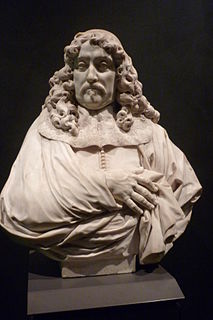
Henri Desmarets was a French composer of the Baroque period primarily known for his stage works, although he also composed sacred music as well as secular cantatas, songs and instrumental works.

Roelof (Roel) Kuiper is a Dutch historian, philosopher, ideologue, politician and university professor. He is a member of the Dutch Senate, and is professor of Reformational philosophy at the Erasmus Universiteit Rotterdam in the name of the Association for Reformational philosophy, teaching Society Issues at the Christelijke Hogeschool Ede and Gereformeerde Hogeschool Zwolle and Political and social philosophy at the Vrije Universiteit Amsterdam (VU).

Gerard or Gérard (de) Lairesse was a Dutch Golden Age painter and art theorist. His broad range of skills included music, poetry, and theatre. De Lairesse was influenced by the Perugian Cesare Ripa and French classicist painters such as Charles le Brun, Simon Vouet and authors such as Pierre Corneille and Jean Racine. His importance grew in the period following the death of Rembrandt. His treatises on painting and drawing, Grondlegginge Ter Teekenkonst (1701), based on geometry and Groot Schilderboek (1707), were highly influential on 18th-century painters.
Carolus Hacquart was a Flemish composer and musician. He became one of the most important 17th-century composers in the Dutch Republic and possibly also worked in England.

Judith Frieda Lina Herzberg is a Dutch poet.

Marie Le Rochois was a French operatic soprano who belonged to the Académie Royale de Musique. She is often referred to as Marthe Le Rochois or simply La Rochois.
Johannes Schenck was a Dutch musician and composer.

Free Imperial Knight Andries de Graeff was a very powerful member of the Amsterdam branch of the De Graeff - family during the Dutch Golden Age. He became a mayor of Amsterdam and a powerful Amsterdam regent after the death of his older brother Cornelis de Graeff. Like him and their father Jacob Dircksz de Graeff he opposed the house of Orange. In the mid-17th century he controlled the finances and politics.
Servaes de Koninck, or Servaes de Konink, Servaas de Koninck or Servaas de Konink, or Servaes de Coninck was a Flemish baroque composer of motets, Dutch songs, chamber and incidental music, French airs and Italian cantatas. After training and starting his career in Flanders he moved to Amsterdam in the Dutch Republic, where he was active in circles connected to the Amsterdam Theatre.

Herman Hendrik ter Balkt was a Dutch poet. He won numerous awards throughout his career, among them the 1988 Jan Campert Prize, the 1998 Constantijn Huygens Prize and the 2003 P. C. Hooft Award. He was born in Usselo, Overijssel and died in Nijmegen.
Nicolaas Bidloo was a Dutch physician who served as the personal physician of Tsar Peter I of Russia. Bidloo was the director of the first hospital in Russia as well as the first medical school in Russia, and is considered one of the founders of Russian medicine.
August Louis Baeyens was a Belgian violist and composer.

Pieter Stevensz. van Gunst, also known as Pieter Stevens van Gunst or Petrus Stephani, was a Dutch draughtsman, copperplate engraver and printmaker active in Amsterdam, London (1704), and the Dutch town of Nederhorst (1730-1731). Prints of engravings by Van Gunst are in the collection of the Rijksmuseum in Amsterdam, Museum Boijmans van Beuningen in Rotterdam, the British Museum and the National Portrait Gallery in London, among others.
Opera in the Dutch-language is a minor tradition in the opera history of the Netherlands. Since the earliest operas were staged in the Netherlands in the 17th Century the preference has always been for original Italian, French and German versions, or occasionally French translations of Italian and German works.








